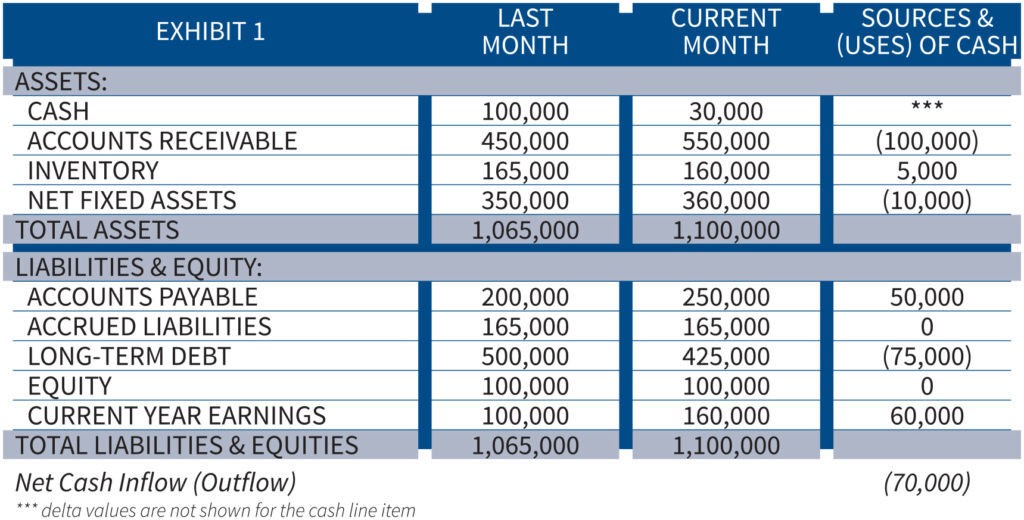What makes a financially successful integration business?

One with high profits?
One with a solid financial plan?
Many owners believe that, if profits are solid, then the company is solid. As we revealed in Part 1 of our blog series, Don’t Be a Cash-Blind Owner, however, they’re pretty upset when they find out that isn’t reality. These are “cash-blind owners” – owners who don’t know anything about their cash flow.
How do you know whether you’re a cash-blind owner?
Try answering these three simple questions:
- Do you know your company’s days sales outstanding (DSO)?
- Do you watch your company’s sources & uses (S&U) of cash?
- Do you know your monthly overhead cash burn rate?
If you can’t answer these questions, you may be in trouble. So, we’re taking a close-up look at each of these financial concepts.
Today’s blog is dedicated to sources & uses (S&U) of cash.
Sources & Uses of Cash
When a business first starts out, most entrepreneurs know the company’s cash balances because they handled the checkbook. If there was insufficient cash in the bank to pay vendors, they held back on paying checks. As the company grows, however, the owner’s cash awareness tends to erode.
Growing companies establish trade credit and bank lines of credit. These borrowed funds allow companies to disburse more cash than is collected from customers in a month. This type of borrowing isn’t visible on the income statement; many owners seldom review their balance sheet activity.
So who’s watching the store? Who knows whether the company is running monthly cash deficits and what’s causing these cash inequities? Are cash deficits the result of timing differences that will turn around in forthcoming months? Or are they permanent sinkholes?
To glean this insight, some business advisors will tell owners to look at their monthly statement of cash flows. However:
- Most enterprise resource planning (ERP) systems do not generate a statement of cash flows as a standard component of the reporting package.
- Many owners don’t have the experience to coherently read a generally accepted accounting principles (GAAP-appropriate) statement of cash flows. What’s a sensible owner supposed to do to determine monthly net cash inflow or outflow?
Fortunately, there’s a basic tool that provides this crucial cash activity information. The tool is called a “Statement of Sources and Uses of Cash”; it’s merely a separate column on an existing comparative balance sheet (see below). Almost any ERP system will allow you to add this one column to an existing system-generated balance sheet without any complex programming.
Why is this one column of information so powerful? Because it delivers critical information. Notice in the example below that the company has a $60,000 profit for the current month but experienced a $70,000 cash drain.
The Sources & Uses column represents the net change in balance sheet line items (assets, liabilities, and equities). Knowing how your cash is being generated or consumed is vital.

Column 1 is the prior month’s balance sheet values. Column 2 is the current month’s balance sheet values. Column 3 is the difference between Column 1 and Column 2. The difference column represents Cash Sources and Cash Uses when formatted correctly.
If assets grow from last month to this month, that is a use of cash. If assets decrease from last month to this month, that is a source of cash. The opposite calculation applies for liabilities and equity. If liabilities or equity grow from last month to this month, that is a source of cash. If liabilities or equity decrease from last month to this month, that is a use of cash. Values in Column 3 are un-bracketed for sources of cash and bracketed for uses of cash. The calculation is just that easy.
This new column tells you what’s happening to your cash. By looking at the S&U column, you can quickly identify whether AR is sucking up $100,000 or if AP is providing $50,000. You can easily see that the monthly $75,000 debt payments are draining cash (even though you never see this transaction on an income statement). You’ll also know that current month profits only contribute $60,000 to offset other cash demands.
A quick glance at this monthly report will alert you to potentially critical shifts in cash activity. The total of all source values and use values yields the net cash inflow or outflow. While this is not a GAAP-acceptable presentation of a statement of cash flows, it is a valid, down-and-dirty appraisal of cash activity for the month.
This article was originally published by our partners at NSCA. Read the original story here: Are You a Cash-Blind Owner Part 2: Sources & Uses of Cash
Stay tuned for Part 3 in this blog series, where we’ll discuss cash burn rate: the rate at which a company spends “in cash” to pay overhead expenses each month.
by Eric Morris, CFO at Wayne Automatic Fire Sprinklers, Inc.
Handpicked Related Content
-
During my decades-long career as a CFO, I’ve had the great pleasure of knowing and interacting with many superbly talented entrepreneurs. Unfortunately, some of these remarkable individuals are also what I call “cash-blind owners.” This “disorder” describes otherwise-savvy business owners…
-
This is the final installment in our blog series about cash flow management, and cash-blind owners. What are cash-blind owners, you wonder? Simply put, they are integration firm owners who are completely oblivious to the monthly cash flow activity of…



